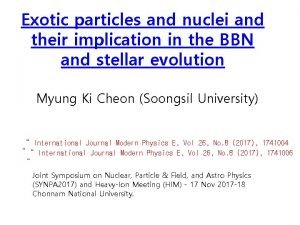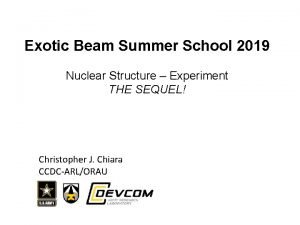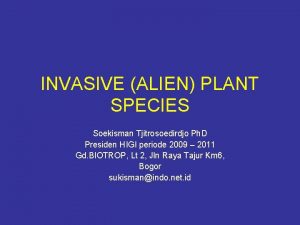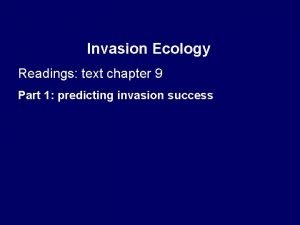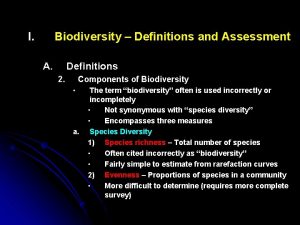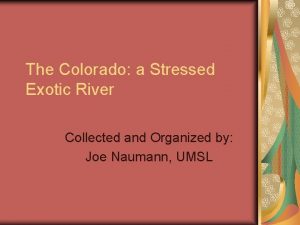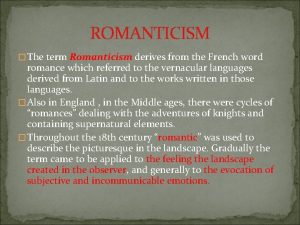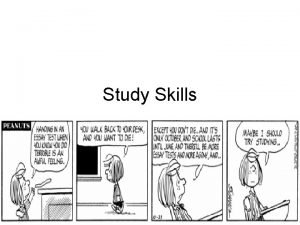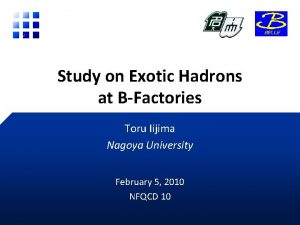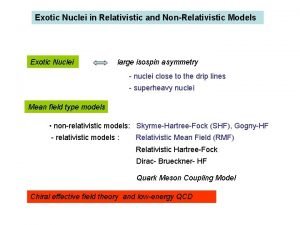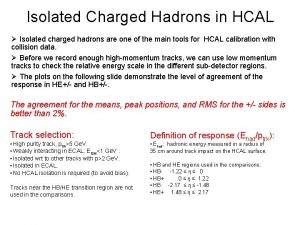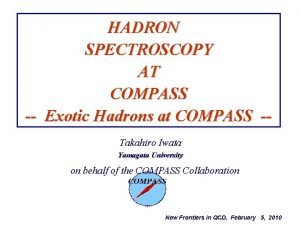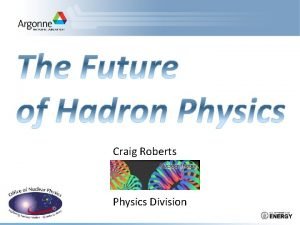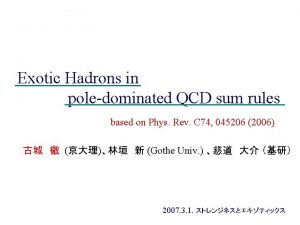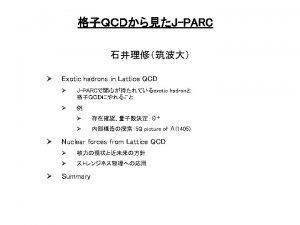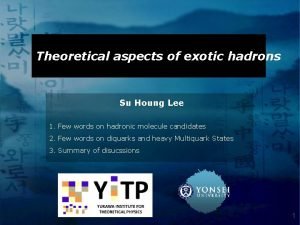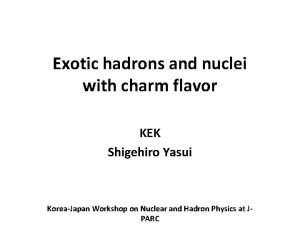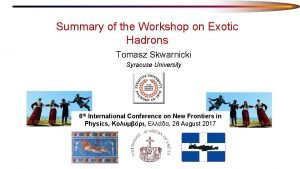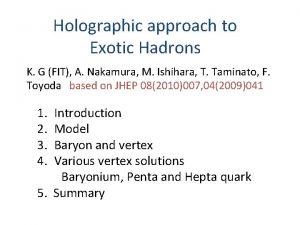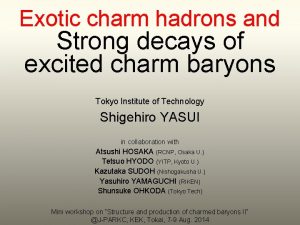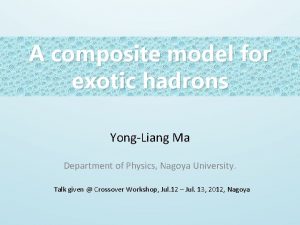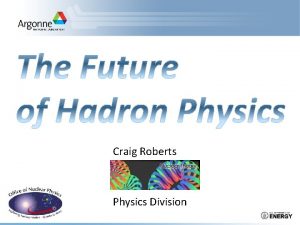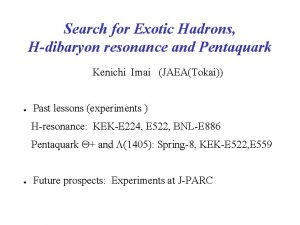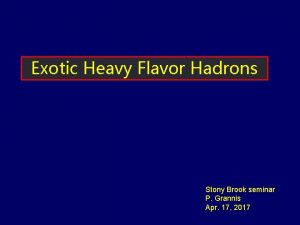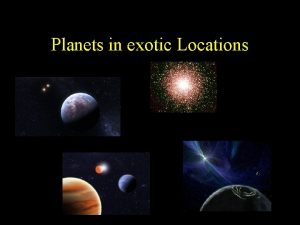Study of exotic hadrons in effective models for














































- Slides: 46

Study of exotic hadrons in effective models for chiral doubling of charmed mesons Masayasu Harada (Nagoya Univ. ) at Heavy Quark Hdrons at J-PARC 2012 (Tokyo Institute of Technology, June 21, 2012) Based on ・ M. H. , H. Hoshino and Y. L. Ma, Phys. Rev. D 85, 114027 (2012) ・ M. H. and Y. L. Ma, work in progress


Chiral partner structure • Chiral symmetry breaking generates the mass splitting between chiral partners. • examples : p N(940) left ⇔ N(940) right [ N(940) ⇔ N*(1535) ] p pi(130) ⇔ sigma(600) [ pi(130) ⇔ rho(770) ] p (D, D*) ⇔ (D 0*, D 1)

“chiral doubling” M. A. Nowak, M. Rho and I. Zahed, PRD 48, 4370 (1993) excited states heavy quark symmetry (heavy quark partner ) ground states chiral symmetry (chiral partner) MD(0+, 1+) – MD(0 -, 1 -) ~ 0. 43 Ge. V Chiral doubling seems to work.

☆ Heavy-Light Mesons (Qq- type) Baryons (Qqq) Q “Light-quark cloud” (Brown Muck) ・・・ made of light quarks and gluons typical energy scale ~ ΛQCD ◎ Heavy mesons ・・・ 3 or 3 bar, … of SU(3)l ◎ Heavy baryons ・・・ 6, … of SU(3)l Flavor representations, which do not exist in the light quark sector, give a new clue to understand the hadron structure.

“chiral doubling” u I shall show what we can learn, from the chiral doubling structure in the heavy meson sector, for • the chiral doubling structure in the light meson sector (chiral partner to pion = sigma meson ? ) • the chiral doubling structure in the heavy baryon sector (chiral partner to Lc and/or Lb ? )

Outline 1. Introduction 2. A brief review of chiral doubling 3. Study of sigma meson structure using a model based on the chiral doubling 4. Chiral doubling in heavy baryons 5. Summary

Heavy quark symmetry and the chiral symmetry 2. A BRIEF REVIEW OF CHIRAL DOUBLING

☆ Heavy quark symmetry ・・・ a symmetry of QCD at MQ → ∞ limit ◎ velocity super-selection rule gluon heavy quark The velocity of a heavy quark is not changed by the QCD interaction. ◎ Heavy quark number conservation No pair production of heavy quarks by QCD interaction. ◎ SU(2) spin symmetry QCD interaction cannot flip the spin of heavy quarks.

• Fluctuation mode around the On-shell Heavy Quark energy of fluctuation mode energy of heavy quark on-shell energy of heavy quark at rest ・・・ Expansion parameter

☆ Heavy-Light Mesons (Qq- type) Q “Light-quark cloud” (Brown Muck) ・・・ made of light quarks and gluons typical energy scale ~ ΛQCD angular momentum carried by “Brown muck” ◎ spin of meson spin of heavy quark ・ MQ → ∞ limit same Jl Q(↑) conservation of Jl ⇒ classification of hadrons by Jl Q(↓) Heavy Meson Multiplet ・・・ degenerate masses

Heavy meson multiplets u Ground states ・・・ Jl =1/2 ; JP = (0 - , 1 -) Ø Pseudoscalar meson D ; Vector meson D* Ø D = ( D 0, D+ , Ds) D* = ( D*0, D*+ , Ds*) chiral partner u Excited states ・・・ Jl =1/2 ; JP = (0+ , 1+) Ø Scalar meson D 0* ; Axial-vector meson D 1 Ø D 0* = ( D 0*0, D 0*+ , Ds 0*) D 1 = ( D 10, D 1+ , Ds 1 )

3. Study of sigma meson structure using a model based on the chiral doubling Based on ・ M. H. , H. Hoshino and Y. L. Ma, Phys. Rev. D 85, 114027 (2012)

Clue to understand the chiral symmetry breaking “σ” particle (“QCD Higgs” particle) ・・・ Quantum fluctuation of the condensate A candidate ・・・ f 0(600) : lightest I=0 scalar meson However, f 0(600) may not be a qqbar meson ! PDG 2009

Scalar meson puzzle mass (Me. V) Contradiction ?

Scalar meson puzzle mass (Me. V) Consistent ?

◎ Standard qqbar quark model assignment What is f 0(600) ? 2 quark ( qqbar ) state “σ” particle 4 quark ( qqqbar ) state Exotic hadron

Outline of this section 3. Study of sigma meson structure using a model based on the chiral doubling A) Linear sigma model for light quark sector including s meson B) s meson in pp scattering C) An effective model for s meson coupling to chiral doublers D) s meson in D 1 → Dpp decay

A) Linear sigma model for light quark sector including s meson

2 and 4 quark states in linear sigma model 3× 3 matrix fields & (Linear Sigma Model): 4 quark field ~ 2 quark field ~ Scalar Pseudo scalar These transform in the same way under SU(3)L×SU(3)R : SU(3)R× SU(3)L: Different transformations under U(1)A : U(1)A:

mixing When the U(1)A symmetry exists, 2 -quark state and 4 -quark state do not mix with each other. But, U(1)A symmetry is broken by anomaly explicitly by spontaneous chiral symmetry breaking ⇒ mixing between 2 -quark state and 4 -quark state Lightest 2 nd 3 rd Heaviest

An effective Lagrangian Linear sigma model including 2 -nonet fields : SU(3)L×SU(3)R invariant, U(1)A invariant. : SU(3)L×SU(3)R invariant, U(1)A breaking (anomaly). constrained by anomaly matching with QCD : Explicit SU(3)L×SU(3)R×U(1)A breaking terms. (effects of current quark masses)

B) s meson in pp scattering

pp scattering amplitude Relations among coupling constants due to the chiral symmetry π π π pp scattering amplitude includes spp couping and sigma mass in the low energy region σ

Fit to pp scattering data

C) An effective model for s meson coupling to chiral doublers

Heavy meson effective field ☆ Ground states ・・・ Jl =1/2 ; JP = (0 - , 1 -) Pseudoscalar meson D ; Vector meson D* D = ( D 0, D + , D s ) ・ Bi-spinor field D* = ( D*0, D*+ , Ds*) ; Y ・・・ light constiuent quark field annihilates heavy mesons (not generate) ☆ Excited states ・・・ Jl =1/2 ; JP = (0+ , 1+) Scalar meson D 0* ; Axial-vector meson D 1 D 0* = ( D 0*0, D 0*+ , Ds 0*) D 1 = ( D 10, D 1+ , Ds 1 )

Heavy meson effective field ◎ chiral doubler fields ・ transformation under the chiral symmetry ・ transformation under U(1)A 2 -quark meson 4 -quark meson

Model Lagrangian D term generates mass difference between (D, D*) and (D 0*, D 1). We use physical masses as inputs to determine D.

Detemination of parameters

D) s meson in D 1 → Dpp decay

D 1 → Dpp decay amplitude mixing parameter

Isospin & partial wave projection To make the sigma meson contribution clearer, we made the projection of the amplitude onto I = 0, S-wave amplitude. From this, we can see that the final state interaction do not change the decay width.

D 1 → Dpp decay width Note : There is 4 -way ambiguity of signs of gspp and gp. gspp > 0 gp > 0 h=1 h=0

D 1 → Dpp decay width gspp > 0 gp > 0 gspp < 0 gp > 0 gspp > 0 gp < 0 gspp < 0 gp < 0 Constituent of sigma meson may be detemined by future experiment

4. Chiral doubling in heavy baryons Based on ・ M. H. and Y. L. Ma, work in progress

Chiral doubling in heavy baryons ・・・ based on the boundstate approach to heavy baryons ☆ Boundstate approach heavy baryons (qq. Q type) = heavy meson (qbar. Q) bound to nculeon (qqq) as a soliton heavy meson r=0 q Q r=1 l=0 D(0 -, 1 -) l=1 D(0+, 1+) D(1+, 2+) ・kinematical structure is same as the constituent quark model M. H. , F. Sannino, J. Schechter and H. Weigel, PRD 56, 4098 (1997)

Nucleon as Skyrme soliton Skyrme model hedgehog ansatz ☆ Eo. M for F(r) - ☆ Solution with Baryon number = 1 ☆ Soliton mass

Heavy meson Lagrangian ☆ Integrating out scalar mesons and keeping pion only ・ Redefine the fields as ・ Ansaz for classical solution

Quantum number & Binding energy ・ Spin of heavy baryon (bound state) ・ Binding energy for H ~ (D, D*) with r = 0 (ground state) from Adkins-Nappi-Witten ・ Assume g. A > 0 for a bound state in K=0 ⇒ Lc(1/2+) is the ground state

Mass of Lc(1/2+) M(L(1/2+)) = MN + MD(0 -, 1 -) – 1. 06 g. A (Ge. V) MD(0 -, 1 -) = ( MD(0 -) + 3 MD(1 -) )/4 ~ 1. 97 (Ge. V) MN = 0. 94 (Ge. V) g. A = 0. 56 from D(1 -) → D(0 -) + p decay M(L(1/2+)) = 2. 32 (Ge. V) M(L(1/2+))exp = 2. 286 (Ge. V) ◎ Bound state approach seems to work !

+ Chiral partner to Lc(1/2 ) ? ◎ Binding energy for G ~ (D 0, D 1*) with r = 0 ・ overall sign is opposite ⇒ bound state is realized for K = 1 Chiral partner to Lc(1/2+) = [ Lc(1/2 -), Lc(3/2 -) ] ◎ Mass MD(0+, 1+) = ( MD(0+) + 3 MD(1+) )/4 ~ 2. 4(Ge. V) M(L) = MN + MD(0+, 1+) – 0. 35 g. A = 3. 1 (Ge. V) ・Lc(1/2 -; 2595) is unlikely the chiral partner to Lc(1/2+; 2286) ・{Lc(1/2 -; 2595) , Lc(3/2 -; 2625) } ・・・ r = 1 boundstate of D(0 -, 1 -) and nucleon

Effects of w meson K=0 from: Y. L. Ma, Y. Oh, G. Yang, M. Harada, H. Lee, B. Y. Park, M. Rho, in preparation; Y. L. Ma, Y. Oh, G. Yang, . M. Harada, in preparation M(L(1/2+))exp = 2. 286 (Ge. V) is used to determin gw = 0. 717 M(L) = 3. 1 (Ge. V) ! K=1

☆ Chiral partner to L(1/2+) ◎ excited heavy baryons (qq. Q type) = heavy meson + nculeon with angular momentum or excited heavy meson + nucleon r, l : angular momentum heavy meson r=0 r=1 q Q l=0 D(0 -, 1 -) l=1 D(0+, 1+) D(1+, 2+) 3. 1 Ge. V

Application to pentaquark K = 1 gives a bound state. M(Qc(1/2 -, 3/2 -)) ~ 2. 4 (Ge. V) cf : M(Qc(1/2 -)) ~ 2. 7 Ge. V without w contribution. Y. Oh, B. -Y. Park, and D. P. Min, PLB 331, 362 (1994) note : CHORUS exp. did not observe Qc(2710). NPB 763 (2007) 268 ☆ chiral partner to pentaquark ? M(Qc(1/2+)) ~ 2. 3 (Ge. V) ! cf : M(Qc(1/2+)) = 3052 ± 60 Me. V K=0 M. A. Nowak et al. , PRD 70, 031503(2004)

5. Summary u Based on the chiral doubling structure of D mesons I showed the following 2 analyses: ◎ effect of the sigma meson to D 1 → Dpp decay • Our result indicates that we can get some clue to understand the composition of the sigma meson from future experiment. ◎ Chiral doubling of heavy baryons • Our result implies that the chiral partner to Lc(1/2+) is [ Lc(1/2 -), Lc(3/2 -) ]. Then, {Lc(1/2 -; 2595) , Lc(3/2; 2625) } is r = 1 boundstates of D(0 -, 1 -) and nucleon • M(Qc(1/2 -, 3/2 -)) = 2. 4 (Ge. V) ; M(Qc(1/2+)) ~ 2. 3 (Ge. V) • Analysis with effect of rho meson is on-going.
 Hadrons
Hadrons Exotic species meaning
Exotic species meaning Exotic nucleosynthesis
Exotic nucleosynthesis Exotic breeds of rabbit
Exotic breeds of rabbit Exotic beam summer school
Exotic beam summer school Interference competition
Interference competition Woman walking in an exotic forest
Woman walking in an exotic forest Beta diversity definition
Beta diversity definition Exotic species definition
Exotic species definition Exotic species definition
Exotic species definition Exotic species definition
Exotic species definition Is the colorado river an exotic stream
Is the colorado river an exotic stream Rolls royce rental austin
Rolls royce rental austin Romsnticism
Romsnticism Static hedging of exotic options
Static hedging of exotic options Modals and semi modals
Modals and semi modals Developing effective study skills
Developing effective study skills Kontinuitetshantering i praktiken
Kontinuitetshantering i praktiken Novell typiska drag
Novell typiska drag Nationell inriktning för artificiell intelligens
Nationell inriktning för artificiell intelligens Returpilarna
Returpilarna Varför kallas perioden 1918-1939 för mellankrigstiden
Varför kallas perioden 1918-1939 för mellankrigstiden En lathund för arbete med kontinuitetshantering
En lathund för arbete med kontinuitetshantering Kassaregister ideell förening
Kassaregister ideell förening Personlig tidbok för yrkesförare
Personlig tidbok för yrkesförare Sura för anatom
Sura för anatom Densitet vatten
Densitet vatten Datorkunskap för nybörjare
Datorkunskap för nybörjare Stig kerman
Stig kerman Debattartikel struktur
Debattartikel struktur Autokratiskt ledarskap
Autokratiskt ledarskap Nyckelkompetenser för livslångt lärande
Nyckelkompetenser för livslångt lärande Påbyggnader för flakfordon
Påbyggnader för flakfordon Lufttryck formel
Lufttryck formel Offentlig förvaltning
Offentlig förvaltning Lyckans minut erik lindorm analys
Lyckans minut erik lindorm analys Presentera för publik crossboss
Presentera för publik crossboss Teckenspråk minoritetsspråk argument
Teckenspråk minoritetsspråk argument Vem räknas som jude
Vem räknas som jude Klassificeringsstruktur för kommunala verksamheter
Klassificeringsstruktur för kommunala verksamheter Mjälthilus
Mjälthilus Claes martinsson
Claes martinsson Centrum för kunskap och säkerhet
Centrum för kunskap och säkerhet Byggprocessen steg för steg
Byggprocessen steg för steg Mat för unga idrottare
Mat för unga idrottare Verktyg för automatisering av utbetalningar
Verktyg för automatisering av utbetalningar Rutin för avvikelsehantering
Rutin för avvikelsehantering


